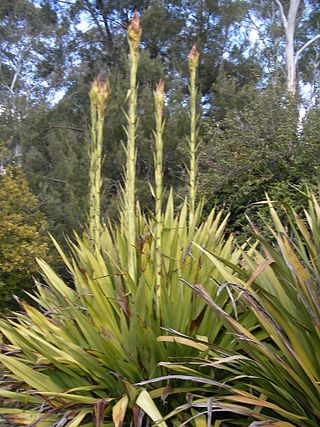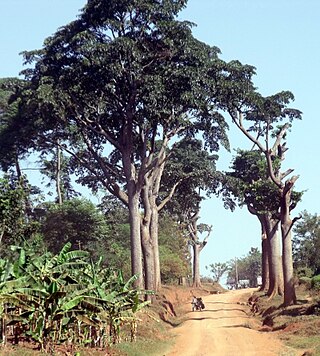
Metrosideros excelsa, commonly known as pōhutukawa, New Zealand Christmas tree, and iron tree, is a coastal evergreen tree in the myrtle family, Myrtaceae, that produces a brilliant display of red flowers, each consisting of a mass of stamens. The pōhutukawa is one of twelve Metrosideros species endemic to New Zealand. Renowned for its vibrant colour and its ability to survive even perched on rocky, precarious cliffs, it has found an important place in New Zealand culture for its strength and beauty, and is regarded as a chiefly tree by Māori.

The Brazil nut is a South American tree in the family Lecythidaceae, and it is also the name of the tree's commercially harvested edible seeds. It is one of the largest and longest-lived trees in the Amazon rainforest. The fruit and its nutshell – containing the edible Brazil nut – are relatively large, possibly weighing as much as 2 kg (4.4 lb) in total weight. As food, Brazil nuts are notable for diverse content of micronutrients, especially a high amount of selenium. The wood of the Brazil nut tree is prized for its quality in carpentry, flooring, and heavy construction.

The Burseraceae are a moderate-sized family of 17-19 genera and about 540 species of woody flowering plants. The actual numbers given in taxonomic sources differ according to taxonomic revision at the time of writing. The Burseraceae are also known as the torchwood family, the frankincense and myrrh family, or simply the incense tree family. The family includes both trees and shrubs; its species are native to tropical regions of Africa, Asia, Australasia, and the Americas.

Juniperus excelsa, commonly called the Greek juniper, is a juniper found throughout the eastern Mediterranean, from northeastern Greece and southern Bulgaria across Turkey to Syria and Lebanon, Jordan, the Caucasus mountains, and southern coast of Crimea.

Doryanthes is the sole genus in the flowering plant family Doryanthaceae. The genus consists of two species, D. excelsa and D. palmeri, both endemic natives of the coast of Eastern Australia. Doryanthaceae is part of the order Asparagales.

Bursera simaruba, commonly known as gumbo-limbo, copperwood, almácigo, chaca, West Indian birch, naked Indian, and turpentine tree, is a tree species in the family Burseraceae, native to the Neotropics, from South Florida to Mexico and the Caribbean to Brazil, Nicaragua, and Venezuela. Bursera simaruba is prevalent in the Petenes mangroves ecoregion of the Yucatán, where it is a subdominant plant species to the mangroves. In the United States, specimens may be found in the Gulf of Mexico along the western coast of Florida.

Rhapis is a genus of about 10 species of small palms native to southeastern Asia from southern Japan and southern China south to Sumatra. The species are commonly known as lady palms. They are fan palms, with the leaves with a bare petiole terminating in a rounded fan of numerous leaflets. The plants have thin stems growing to 3–4 m tall, branching at the base, forming clumps and are dioecious, with male and female flowers produced on separate plants.

Milicia excelsa is a tree species from the genus Milicia of the family Moraceae. Distributed across tropical Central Africa, it is one of two species yielding timber commonly known as African teak, iroko, intule, kambala, moreira, mvule, odum and tule.

Bursera microphylla, known by the common name elephant tree in English or 'torote' in Spanish, is a tree in genus Bursera. It grows into a distinctive sculptural form, with a thickened, water-storing or caudiciform trunk. It is found in the southwestern United States and northwestern Mexico.

Dacryodes excelsa is a tree native to Puerto Rico with a habitat that extends into the Lesser Antilles in the Caribbean region. Its English vernacular names include gommier and candlewood. Its Spanish common name is tabonuco. According to Richards, "it is the most conspicuous large emergent tree" in the Luquillo mountains of Puerto Rico. It is also found in Toro Negro State Forest, in Puerto Rico Cordillera Central. Dacryodes excelsa grows to around 115 feet (35 m), and grows best in soil with a PH of 4.5–5.5.

Alphitonia excelsa, commonly known as the red ash or soap tree, is a species of tree in the family Rhamnaceae. It is endemic to Australia, being found in New South Wales, Queensland, Northern Territory and the northeastern tip of Western Australia. It is used in bush regeneration as a pioneer species and for amenity planting.

Bursera glabrifolia is a species of tree native to central Mexico.

Bursera fagaroides is a species of flowering plant in the genus Bursera known by the common names torchwood copal and fragrant bursera. It is widespread across much of Mexico from Sonora to Oaxaca, and its range extends just into Arizona in the United States, although some sources suggest that it may now be extirpated in Arizona.

The Waterman Mountains are a low mountainous landform in Pima County, United States. Notable among the tree species is the elephant tree which species exhibits a contorted multi-furcate architecture; most of these froze in the cold winter of 2011. The Waterman Mountain range is in the Ironwood Forest National Monument.

Iroko is a large hardwood tree from the west coast of tropical Africa that can live up to 500 years. This is the common name for the genus Milicia, in which there are two recognized species, which are closely related: Milicia excelsa and Milicia regia.

Bursera bipinnata is a Mesoamerican species of trees widespread across Mexico and Central America from Chihuahua to Honduras.

Bursera penicillata is a Mexican species of trees in the frankincense family in the soapwood order. It is widespread in much of Mexico from Sonora and Chihuahua to Oaxaca and Veracruz.

The Southern Pacific dry forests is a tropical dry broadleaf forest ecoregion in southern Mexico.
Bursera refers to a genus of plants with about 100 described species

















